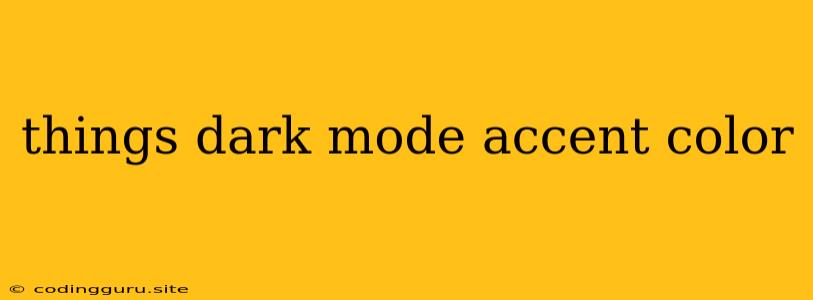Things to Consider When Choosing a Dark Mode Accent Color
Dark mode has become increasingly popular, offering a more comfortable and visually appealing experience for users. However, choosing the right accent color can be crucial in creating a harmonious and effective dark mode design. Here's a guide to help you make the best choice:
Why Accent Colors Matter in Dark Mode
Accent colors play a significant role in dark mode design. They act as visual cues, highlighting important elements and enhancing user engagement. In a dark mode environment, where white space is limited, accent colors help to:
- Improve readability: By contrasting with the dark background, they make text and other elements easier to read.
- Enhance visual hierarchy: They draw attention to specific components and create a clear visual hierarchy.
- Add visual interest: They break up the monotony of dark backgrounds and add a touch of vibrancy.
- Reflect brand identity: They can be used to reinforce your brand's personality and create a consistent look and feel.
Factors to Consider When Choosing a Dark Mode Accent Color
Here are some important factors to consider when choosing your accent color:
1. Color Contrast:
- High Contrast: This is essential for readability and accessibility. Use a color that provides sufficient contrast against the dark background.
- Color Blindness: Consider how your chosen color will appear to individuals with color blindness. Tools like Coblis can help you test your color choices.
2. Color Psychology:
- Brand Personality: Choose a color that aligns with your brand's personality. For instance, a bright, energetic brand might opt for a bold accent color, while a sophisticated brand might choose a more muted tone.
- User Emotion: Consider the emotion you want to evoke in your users. Warm colors like orange or yellow can create feelings of excitement and energy, while cool colors like blue or green can create a calming effect.
3. Color Scheme:
- Color Harmony: Ensure that the chosen color complements the overall dark mode color scheme. Consider using color wheels or online tools to help you create harmonious combinations.
- Color Combinations: Test various combinations of accent colors to see what works best with your design.
4. User Feedback:
- A/B Testing: Run A/B tests to gather user feedback on different accent color choices. This data can help you make informed decisions about your final selection.
Tips for Choosing Effective Dark Mode Accent Colors
- Embrace complementary colors: A classic approach is to use complementary colors, which appear opposite each other on the color wheel. For example, a dark blue background might be paired with an orange accent color.
- Utilize analogous colors: Analogous colors are located next to each other on the color wheel, offering a harmonious and calming feel. For example, a deep blue background could be paired with purple and teal accent colors.
- Go bold with monochromatic colors: Monotone schemes involve using different shades of the same color, creating a sleek and modern look. For instance, a dark gray background can be paired with lighter shades of gray for accents.
- Experiment with shades and hues: Explore different shades and hues of your chosen color to find the perfect balance.
Examples of Dark Mode Accent Colors
- Blue: Blue is often associated with trustworthiness, calmness, and professionalism.
- Green: Green can convey growth, stability, and nature.
- Orange: Orange evokes energy, enthusiasm, and creativity.
- Yellow: Yellow is a bright and cheerful color that can enhance visibility.
- Pink: Pink can be used to convey femininity, kindness, and playfulness.
Remember: The best accent color for your dark mode design will depend on your specific needs and preferences. By carefully considering these factors and experimenting with different options, you can create a dark mode experience that is both aesthetically pleasing and user-friendly.
Conclusion
Choosing the right accent color for your dark mode design can significantly impact user experience. By considering factors such as color contrast, psychology, scheme, and user feedback, you can select a color that enhances readability, visual hierarchy, and brand identity. Experiment with different options and don't be afraid to embrace bold choices. With the right approach, you can create a dark mode experience that is both visually appealing and effective.
